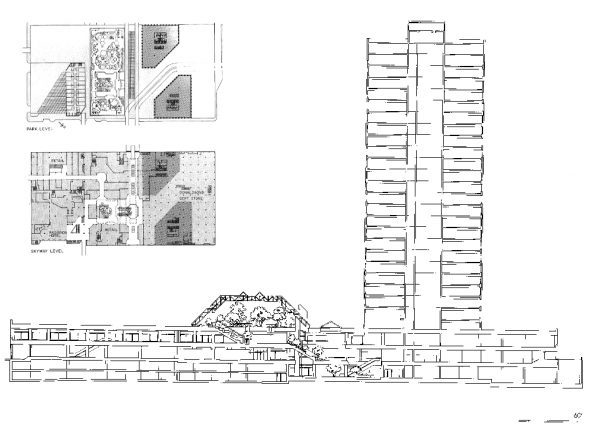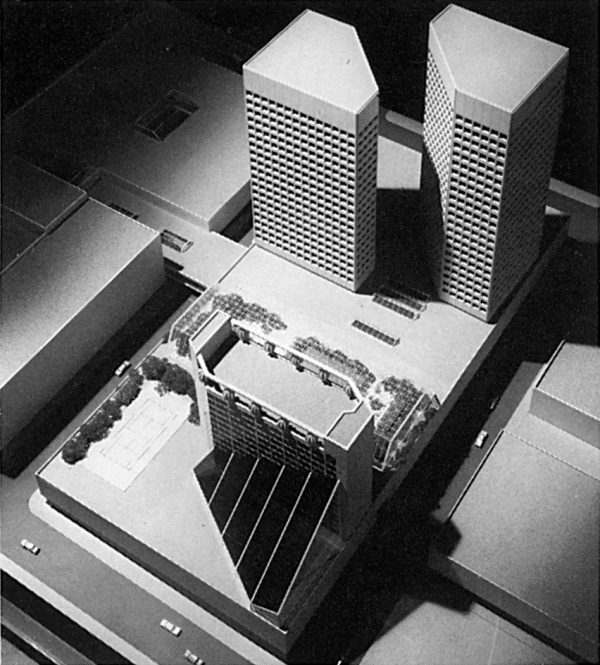Aside from the humans for whom cities are designed, few mammals can rival the raccoon when it comes to thriving in urban environments. Earlier this week, one particularly audacious “trash panda” showed off her tenacity on an epic building climb in the heart of St. Paul, Minnesota. This is the tale of that creature, but also of the relatively unassuming architecture that facilitated her breathtaking adventure.
The saga started out simply enough on the lower levels of a large downtown building complex. A raccoon had been spotted the day before, curled up on a ledge just one floor above the entry ramp of an underground parking lot, and some were concerned about its health.
When well-meaning maintenance workers tried to help her down, however, she scooted off sideways, wrapping around a series of concrete columns and then up to a lower-level roof. This was, as it turned out, just the beginning of a long ascent.
As she began to make her way up the 25-story UBS Plaza tower, the “MPR raccoon” (so-named by a Minnesota Public Radio reporter) began to draw more and more realtime coverage.
Twitter users followed along as MPR employees from the building next door (and people inside the UBS tower) tracked her progress. Local TV stations WCCO and KARE 11 soon began to set up live video feeds.
Eventually, at 2:30 AM the next morning, she reached the top, where a dish of soft cat food awaited in a live trap. She was caught safely and enjoyed a well-earned meal before being released back into the wild.
In hindsight, the sequence sounds straightforward. But for those who actively watched this journey to the summit, things unfolded in fits and starts. The raccoon took extended breaks on ledges along the way, spent dizzying moments searching for footholds and followed a circuitous route to the top. And this meandering path was shaped by a design dating back decades to a period of urban redevelopment.

Originally called the Conwed Tower, the UBS Plaza building was completed in 1980 as part of a new Town Square complex spanning two city blocks. The project design was led by Skidmore, Owings and Merrill (SOM), one of the largest architecture firms in the United States, and added over a million square feet of urban residential, office and civic space to the growing city of St. Paul. It was scaled and situated to relate to (and optimize views of) the surrounding urban context.

For maximum utility in a region with a famously extreme climate, the extensive lower “podium” (connecting the towers) featured an enclosed atrium with open interior play, lecture, and amphitheater spaces plus areas for parties, gatherings and cultural events. The complex was also connected to adjacent structures via skyways, a network of enclosed bridges for over-street travel common in both Twin Cities.

Without a climbing raccoon, it is probably not the kind of place people would seek out to snap a selfie, but the building was innovative for its time — a mixed-use urban oasis with indoor greenery, it employed well water as part of an energy-saving geothermal cooling system, dropping its conventional energy demands to half that of neighboring structures.

The Conwed building was paired with a slightly taller adjacent tower, which was intentionally positioned to shade its smaller twin at peak daytime hours. Both buildings were constructed of steel-reinforced, cast-in-place concrete with precast concrete panels along their facades — panels with a notably rough and rocky texture.
The architects had no idea that the building’s exterior surface would one day serve to provide pawholds. They also couldn’t have anticipated that the non-operable windows (historically typical of tall towers) might be a focal point for people concerned about a stranded raccoon (in retrospect: their inability to open may have been a plus, since rescue attempts might have spooked her). Nor would they have guessed that terminating exterior columns toward the top would be an issue.
As the MPR raccoon made her way up, generous ledges proved to be critical stopping points, but the flat facade below the roofline appeared ominous. She had climbed rounded columns most of the way, straddling them to help maintain her grip. Far into the evening, she kept getting close to the tops of these then climbing back down.
Like the Modernist pediment of some tall minimalist Greek temple, the last stretch was too big a transition from the columns below — except at the corner. Between two flat sides, the edge of the building remained rounded. And after a day of climbing up, down and sideways, it was this curving detail that finally allowed this raccoon up to the top.
The now-famous MPR raccoon climbed over the edge and into a live trap before being set free again at an undisclosed location.




Comments (3)
Share
This is why I love you folks.
I work in the UBS building. I gotta say, it’s a pretty soul-less piece of architecture. But thank you for giving me perspective about the aspects of its design that were considered innovative at the time it was built. And thanks for feelin’ the love with our dear #mprraccoon! Long may she thrive.
Love your podcasts.
Why do we care that an animal is interacting with the human built world? Would we care if it was climbing a tree?
It seems that humans feel a innate scense of guilt that the things we create interacted with in ways we did not expect by those creature of the environment, in ways that are quite normal for the creature but frighting for the human. And we transfer that fear on the creature. Or is is just fun to see if it will fall off. Who know humans are most strange creature themselves.